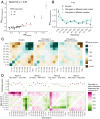This is a preprint.
Fine-scale spatial and social patterns of SARS-CoV-2 transmission from identical pathogen sequences
- PMID: 38826243
- PMCID: PMC11142302
- DOI: 10.1101/2024.05.24.24307811
Fine-scale spatial and social patterns of SARS-CoV-2 transmission from identical pathogen sequences
Update in
-
Fine-scale patterns of SARS-CoV-2 spread from identical pathogen sequences.Nature. 2025 Apr;640(8057):176-185. doi: 10.1038/s41586-025-08637-4. Epub 2025 Mar 5. Nature. 2025. PMID: 40044856 Free PMC article.
Abstract
Pathogen genomics can provide insights into underlying infectious disease transmission patterns, but new methods are needed to handle modern large-scale pathogen genome datasets and realize this full potential. In particular, genetically proximal viruses should be highly informative about transmission events as genetic proximity indicates epidemiological linkage. Here, we leverage pairs of identical sequences to characterise fine-scale transmission patterns using 114,298 SARS-CoV-2 genomes collected through Washington State (USA) genomic sentinel surveillance with associated age and residence location information between March 2021 and December 2022. This corresponds to 59,660 sequences with another identical sequence in the dataset. We find that the location of pairs of identical sequences is highly consistent with expectations from mobility and social contact data. Outliers in the relationship between genetic and mobility data can be explained by SARS-CoV-2 transmission between postal codes with male prisons, consistent with transmission between prison facilities. We find that transmission patterns between age groups vary across spatial scales. Finally, we use the timing of sequence collection to understand the age groups driving transmission. Overall, this work improves our ability to leverage large pathogen genome datasets to understand the determinants of infectious disease spread.
Conflict of interest statement
ALG reports contract testing from Abbott, Cepheid, Novavax, Pfizer, Janssen and Hologic, research support from Gilead, and salary and stock grants for LabCorp an immediate family member, outside of the described work. All other authors declare no competing interests.
Figures




Similar articles
-
Fine-scale patterns of SARS-CoV-2 spread from identical pathogen sequences.Nature. 2025 Apr;640(8057):176-185. doi: 10.1038/s41586-025-08637-4. Epub 2025 Mar 5. Nature. 2025. PMID: 40044856 Free PMC article.
-
Within-host diversity improves phylogenetic and transmission reconstruction of SARS-CoV-2 outbreaks.Elife. 2023 Sep 21;12:e84384. doi: 10.7554/eLife.84384. Elife. 2023. PMID: 37732733 Free PMC article.
-
Cryptic transmission of SARS-CoV-2 in Washington State.medRxiv [Preprint]. 2020 Apr 6:2020.04.02.20051417. doi: 10.1101/2020.04.02.20051417. medRxiv. 2020. Update in: Science. 2020 Oct 30;370(6516):571-575. doi: 10.1126/science.abc0523. PMID: 32511596 Free PMC article. Updated. Preprint.
-
Sentinel Surveillance System Implementation and Evaluation for SARS-CoV-2 Genomic Data, Washington, USA, 2020-2021.Emerg Infect Dis. 2023 Feb;29(2):242-251. doi: 10.3201/eid2902.221482. Epub 2023 Jan 3. Emerg Infect Dis. 2023. PMID: 36596565 Free PMC article. Review.
-
The role of pathogen genomics in assessing disease transmission.BMJ. 2015 May 11;350:h1314. doi: 10.1136/bmj.h1314. BMJ. 2015. PMID: 25964672 Review.
References
-
- Russell CA, Jones TC, Barr IG, Cox NJ, Garten RJ, et al. (2008) The global circulation of seasonal influenza a (H3N2) viruses. Science 320: 340–346. - PubMed
Publication types
Grants and funding
LinkOut - more resources
Full Text Sources
Miscellaneous
